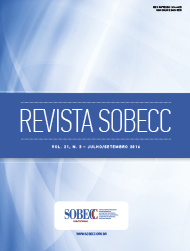Logistics of a surgical block implementation in the forest: the nurse’s role
DOI:
https://doi.org/10.5327/Z1414-4425201600030007Keywords:
Nursing. Logistics. Surgicenters. Health of indigenous peoples. Volunteers.Abstract
Objective: To report the experience of volunteer nurses at the Civil Society Organization for Public Interest “Expedicionários da Saúde” during the
implementation process of surgical, supply and sterilization centers of a field hospital in an indigenous village in northern Brazil. Methods: Descriptive and
narrative experience report, with a qualitative approach conducted from September to November 2015. Results: The structural process and the implementation
of surgical, supply and sterilization centers in isolated areas included five stages, which depended on the participation and involvement of nurses in activities
ranging from planning and management to the execution phase. Conclusion: Nurse’s professional engagement and commitment in all stages contribute to
ensuring the safety and quality of surgeries performed on indigenous patients, an effort that prioritizes organization, systematization, and scientific processes.
References
Brasil. Constituição da República Federativa do Brasil: texto
constitucional promulgado em 5 de outubro de 1988, com as
alterações adotadas pelas Emendas constitucionais nos 1/1992 a
/2015, pelo Decreto legislativo nº 186/2008 e pelas Emendas
constitucionais de revisão nos 1 a 6/1994. 45a ed. Brasília: Câmara
dos Deputados, Edições Câmara; 2015.
Brasil. Lei nº 8.080, de 19 de setembro de 1990. Dispõe sobre as
condições para a promoção, proteção e recuperação da saúde, a
organização e o funcionamento dos serviços correspondentes e dá
outras providências. Brasília: Diário Oficial da União, 20 set. 1990.
Seção 1, p. 18055.
Brasil. Política nacional de atençã o à saúde dos povos indígenas.
Brasília: Fundaçã o Nacional de Saúde; 2002 [acesso em 2016 mar
, 40 p. Disponível em: <http://bvsms.saude.gov.br/bvs/publicacoes/
politica_saude_indigena.pdf>
Fior CA, Mercuri E. Formação universitária e flexibilidade curricular:
importância das atividades obrigatórias e não obrigatórias. Psicol
Educ. 2009;29:191-215.
Nunes DCG. Qual a importância do trabalho voluntário para a
sustentabilidade de organizações não-governamentais? [dissertação].
Programa de Pós-Graduação em História, Política e Bens Culturais.
Rio de Janeiro: Fundação Getúlio Vargas; 2009.
Conselho Federal de Enfermagem (COFEN) [Internet]. Resoluçã o
COFEN nº 424, de 19 de abril de 2012. Normatiza as atribuiçõ es dos
profissionais de enfermagem em Centro de Material e Esterilizaçã o
e em empresas processadoras de produtos para saúde. Brasília:
Diário Oficial da União, 23 abr. 2012. Seção 1, p. 186.
Backes DS, Backes MS, Erdmann AL , Büscher A. O papel profissional
do enfermeiro no Sistema Único de Saúde: da saúde comunitária à
estratégia de saúde da família. Ciênc Saúde coletiva. 2012;17(1):223-30.
Fonseca RMP, Peniche ACG. Enfermagem em centro cirúrgico:
trinta anos após criação do Sistema de Assistência de Enfermagem
Perioperatória. Acta Paul Enferm. 2009;22(4):428-33.
Oliveira JWB, Aquino JM, Monteiro EMLM. Promoção da saúde na
comunidade indígena Pankararu. Rev Bras Enferm. 2012;65(3):437-44.
Silva NC, Gonçalves MJF, Lopes Neto D. Enfermagem em saúde
indígena: aplicando as diretrizes curriculares. Rev Bras Enferm.
;56(4):388-91.
Braga EM, Berti HW, Risso ACMCR, Silva MJP. Relaçõ es interpessoais
da equipe de enfermagem em centro cirúrgico. Rev SOBECC.
;14(1):22-9.
Brasil. Resoluçã o RDC nº 50, de 21 fevereiro de 2002. Regulamento
técnico para planejamento, programaçã o, elaboraçã o e avaliaçã o de
projetos físicos de estabelecimentos assistenciais de saúde. Brasília:
Diário Oficial da União, 20 mar. 2002.
Brasil. Resoluçã o RDC nº 15, de 15 de março de 2012. Dispõe sobre
requisitos de boas práticas para o processamento de produtos para
saúde e dá outras providências. Brasília: Diário Oficial da União,
mar. 2012. Seçã o 1, p. 43-6.
Sociedade Brasileira de Enfermeiros de Centro Cirúrgico, Recuperação
Anestésica e Centro de Material e Esterilização (SOBECC). Práticas
Recomendadas SOBECC. 6a ed. São Paulo: SOBECC; 2013.
Ng-Kamstra JS, Riesel JN, Arya S, Weston B, Kreutzer T, Meara JG,
et al. Surgical non-governmental organizations: global surgery’s
unknown nonprofit sector. World J Surg. 2016;40(8):1823-41.
Charities Aid Foundation. World Giving Index 2013: a global view of giving
trends [Internet]. 2013 dez [citado 2016 mar. 28]. Disponível em:
www. cafonline.org/PDF/WorldGivingIndex2013_1374AWEB.pdf>
Snyder M, Omoto AM. Volunteerism: social issues perspectives and
social policy implications. Soc Issues Policy Rev. 2008;2(1):1-36.
Ribeiro AA , Fortuna CM, Arantes CIS. Nursing work in an indigenous
support institution. Texto Contexto - Enferm. 2015;24(1):138-45.
Santos MC, Rennó CSN. Indicadores de qualidade da assistência de
enfermagem em centro cirúrgico: Revisão Integrativa da Literatura.
RAS. 2013;15(58):27-36.
Freitas NQ, Dissen CM, Sangoi TP, Beck CLC, Goulart CT, Marion R. O
papel do enfermeiro no centro cirúrgico na perspectiva de acadêmicas
de enfermagem. Rev Contexto & Saúde. 2011;11(20):1133-6.
Downloads
Published
How to Cite
Issue
Section
License
By publishing in Revista SOBECC, authors retain the copyright of their article and agree to license their work using a Creative Commons Attribution (CC BY 4.0) International Public License, thus accepting the terms of this license. The CC BY 4.0 license allows others to distribute, remix, adapt, and create from the published article, even for commercial purposes, provided they give due credit to the creators of the work (authors of the article).
The authors grant to Revista SOBECC the right of first publication, to identify itself as the original publisher, and grant to the journal a non-exclusive license to use the work in the following ways: (1) to sell and/or distribute the article in hard copies and/or in electronic format; (2) to distribute parts and/or the entire article in order to promote the journal through the internet and other digital and printed media; (3) to record and reproduce the article in any format, including digital media.
With this license, authors can enter into separate contracts for non-exclusive distribution of the article (e.g., publishing in an institutional repository or as a book chapter), with acknowledgement of authorship and initial publication in Revista SOBECC. Authors are encouraged to publish and distribute their work online after publication in the Revista SOBECC, as this can increase the article's visibility and impact.
In line with the journal's policies, each published article will be assigned a CC BY 4.0 license, which will be visible on the abstract page and in the PDF of each article with the respective link to the license terms.











